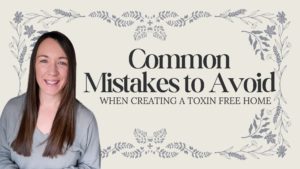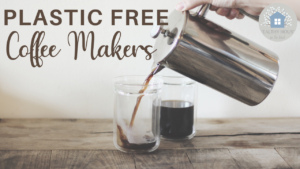
One of the biggest reasons why I started down this path of creating a less toxic space in my house was because I became a mom. There’s this moment when you realize that your choices are going to affect this tiny little person for the rest of their lives. It was when I realized that my health and how I took care of myself was ultimately going to affect them — in many ways. And because so much our health and living is intertwined and connected, I saw that the toxins I was bringing into my house and the toxins that were simply just “there” in my indoor spaces were going to affect these sweet little faces just as much as the food I gave them. So when I started thinking about playroom ideas and creating a truly toxin free play space for my kids, I knew I wanted to keep toxins out of the space as much as possible.
Kids are absolutely resilient, but here’s the thing: pound for pound, kids are coming into contact with vastly more chemicals and toxins than we are as adults. Not to mention that their bodies are undeveloped and somewhat vulnerable to a variety of toxins that can affect their brain and development (STUDY)
While there are so many ways to provide a foundation of health and wellness for our children, one of the big ways is to create a play space that limits toxins, and for some it’s coming up with playroom ideas that reduce chemicals in their space. Whatever is surrounding our children and their bodies will end affecting them as they absorb toxins through their skin and breathe toxins into their lungs.
And while adults may not ingest many toxins that aren’t in a food source, kids are so different this way. I can’t count the number of times I’ve said “hands out of your mouth” in the last nine years since my first daughter was born. Kids have hand to mouth habits that follow them much longer than just infancy and because of this they actually ingest more toxic house dust than we might think. And because our dust is made up of what we bring into our space, it’s important that the play space for our kids follows healthy playroom ideas to keep toxins out.

COMPONENTS OF A TOXIN FREE PLAY SPACE
Flooring/Rug: Flooring is often a particularly toxic component of our homes. Synthetic carpet contains toxins like flame retardants and phthalates. These toxins are known hormone disruptors and affect development in children as well as contribute to reproductive toxicity and neurological toxicity in kids and adults. With kids spending SO much time on the floor playing and having poor hand to mouth habits, flooring choices are ESPECIALLY important for them.
If you have the option to put a rug down on either carpet of smooth surface flooring, you can improve the space by creating a low toxin or toxin free surface for your kids to play on. This post about organic and natural rugs will be a big help when you go to shop for a new rug to match your playroom ideas.
Low Toxin Storage: Avoiding plastic wherever you can is key when you’re creating a toxin free space. Plastic contains toxins that can both be off-gassed and tiny particles that can end up in the air. The toxins in plastics play a huge role in hormone disruption — especially in littles. This hormone disruption can trickle down to autoimmune disorders, reproductive issues, immune suppression and thyroid issues.
Opt for natural materials for toy and craft storage in your play space. You can find tons of playroom ideas that are along the lines of cleaning and storage solutions that aren’t plastic if you head to Pinterest or google.
Some of my favorite materials are metal, cloth baskets, natural fibers like rattan or sisal/jute or wooden storage.
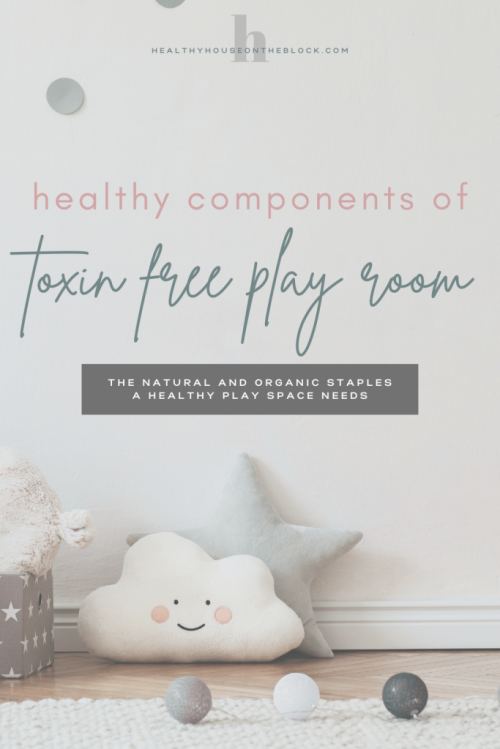
Natural Textiles: Pillows, drapes and upholstered furniture can be treated with formaldehyde and PFOAs in order to make the fabric stain resistant and more water repellent. The fabric from these textiles becomes a part of our dust through friction of use and washing. And these tiny little particles that contain flame retardants, formaldehyde, pesticides and other VOCs actually end up in our dust and in our air.
Once these toxins are in the air we have the ability to ingest them and inhale them, burdening our bodies with immune system suppressors and hormone disruptors.
Finding textiles that are 100% natural cotton (organic is best), GOTS Certified or that meet the OEKO -TEX 100 Standard are best when looking for pillows, drapes, upholstery, etc.
Toxin Free Furniture: Toxin free furniture can be really difficult to find at an affordable price. I like to help families find natural wooden pieces that they can either finish themselves or opt for low toxin furniture that is mostly toxin free. But the nice thing about a playroom and playroom ideas for creating a cozy space, is that generally not too much furniture is needed.
You can find all sorts of unfinished furniture once you start looking and then just opt to finish it in the non toxic stain or paint you want. I love this kids’ table set from International Concepts that is completely unfinished and made of an eco friendly wood.
The biggest thing you want to avoid when it comes to furniture in the playroom is plastic, plywood, particle board or MDF. While all of these are usually the most inexpensive option, they’re also the ones that contain the most amount of chemicals like formaldehyde and PVC toxins.
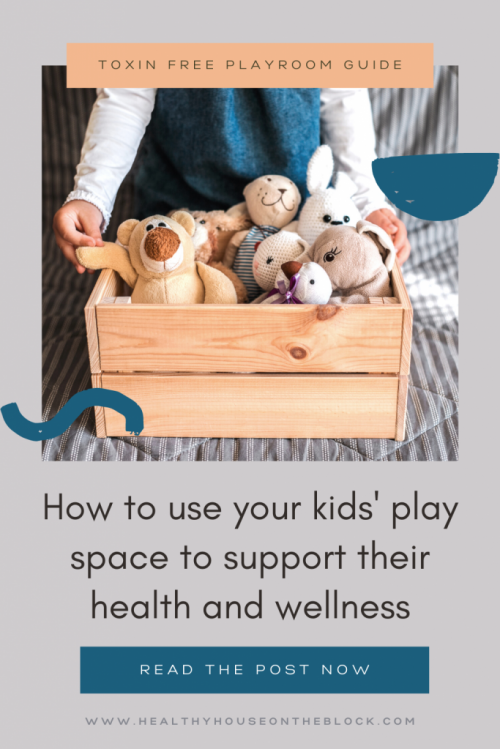
PLAYROOM IDEAS FOR OPEN ENDED PLAY
Healthy Art Supplies: My kids adore arts and crafts and anything that allows them to create. In fact, their kindergarten teacher created what she called a “Lightbulb Lab” in their classroom filled with cardboard, recyclable items, buttons, tape, fabric — whatever anyone wanted to donate to this space. In the lightbulb lab there are no creations that are “wrong” or mistakes. You can use your imagination to build or make whatever it is you want.
I’ve put together a little shelf that is a lot like the lightbulb lab in our own home to foster more of this imaginative creativity. I love using a play space as an area to freely create. Be sure that your crafting materials and art supplies are low toxin and safe for your kids. This post that I wrote up on toxin free craft supplies will help you make sure you’re not introducing toxins to your playroom or play space.
Avoid Clutter & Too Many Toys: The fact of the matter is that kids become overwhelmed when there are just too many choices. This is especially true of toys and items in their play space. In our house we have a bin of toys that are really well loved and we rotate them into the play space while rotating other toys out of the play space. This tactic not only gives new life to old toys, but it prevents the overwhelming of seeing so many items to choose from.
Another added benefit is that there’s just less to clean up or put away. Use storage bins and baskets to keep toys “put away” when they’re not in use so that your child won’t be distracted by new objects. The longer a child can keep their attention on one particular object, the better it is for their long term brain development.
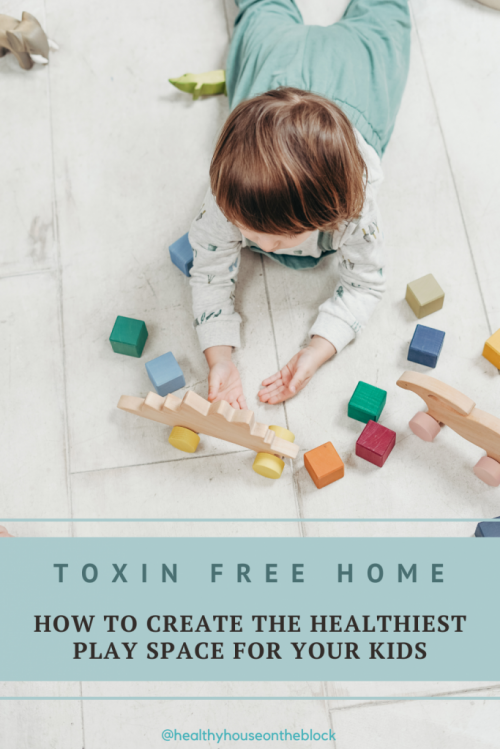
Yes Space: Having a yes space is something I picked up from RIE Parenting. Essentially it’s the idea that you create a space in your home for your kids where you don’t have to hover over them to ensure they’re safe. It not only promotes independent play, but it’s a great way to get their creative minds going.
Janet Lansbury is my go-to source for tons of ideas to make any space a YES space for ages infant to toddler. She encourages parents to let babies and toddlers play for periods of time by themselves to discover the world around them in a safe area where you don’t necessarily need to be right there interacting with them the whole time.
Open Ended Toys: Another tactic I picked up from RIE Parenting is the idea of open ended toys. We implemented this at our house unintentionally and then just kept it going as my girls got older. Essentially the idea is to give kids toys that could be used in many different ways as opposed to just one intended function.
An example might be to give your child a container filled with wooden discs. These wooden discs could become money, cucumber slices, stepping stones for their dolls, etc. Whereas if you give a child a play food cucumber, it will likely always be played with as a cucumber. And if you give them play money, chances are it will be used as play money each time they are playing.
Open ended toys foster creativity and ingenuity as children are allowed to be imaginative with their toys as they play together or on their own.

HEALTHY HABITS FOR YOUR PLAY AREA
Wash Plush Toys: I’m no stranger to an overabundance of plush toys. The Christmas my middle daughter turned three she received not one but four plush puppies — all of which we still have. I might have failed miserably at keeping plush toys limited in our home, but there are ways that I work to keep them free of dust mites and toxic dust.
- Wash and dry stuffed animals in the washer and dryer (if possible).
- Add plush toys to the dryer and run on the hottest setting for 20 – 30 minutes
- You can put plush toys in the freezer for 60 minutes to kill any dust mites. Give them a vigorous shake afterwards to remove any dust and debris in the toy
Air Out Your Space: Especially if your playroom or play space is in the attic or basement of your home, you’ll want to make sure that you’re getting fresh air inside on a regular basis. Heavier toxins like Radon can pool in lower levels of homes creating an unsafe area for kids to spend time.
Other toxins like VOCs can also become concentrated in areas that have poor ventilation or don’t get the proper number of air exchanges. An area that doesn’t receive fresh air on a regular basis tends to have a higher level of toxins. This is usually because the toxins in the air have no place to go and simply stay stagnant in the space they’re residing.
You can easily air out a room by opening windows or turning on either a ceiling fan or HVAC fan that will get air moving throughout the space.

Toxin Free Cleaning: Cleaning your kids’ play space is important to remove dust that contains toxins as well as potential viruses and bacteria. I’d like to also throw in that this doesn’t mean you need to SANITIZE the space. Over-sanitizing and sterile spaces can be harmful to our kids’ immune systems and development. Essentially, kids need to be exposed to a diversity of microbes to actually protect them from future illness and disease. (STUDY)
However, dust in your home can also harbor toxins and pesticides that can greatly affect the health of the kids who come in contact with it. Kids in general have hand-to-mouth habits that allow dust into their mouths on a daily basis. House dust contains microplastics, flame retardants, and pesticides that can negatively affect a child’s development. These toxins contribute to endocrine disruption that will ultimately affect behavior (ADHD), brain development and immune function. (STUDY) They also contribute to the rise of asthma and allergies in children. (STUDY)
To keep a play area clean but not over-sanitized, make dusting and vacuuming a part of your routine every week. You can also clean surfaces with a toxin free multipurpose cleaner to wipe away any extra dust or unwanted bacteria.
Limit Plastic: I realize this one is easier said than done, but it’s worth a try. Even still I try to limit the number of plastic items that come into the house and when my kids were little this meant trying to limit some of the toys that were plastic. While this didn’t mean I threw away the toys they had, it meant that I committed to being VERY intentional about what we bought for the kids to play with.
To be honest, we rarely ever bought toys for the playroom or our kids because they enjoyed so many other items that were not toys at all: Kitchen utensils, craft supplies, pieces of fabric, etc. Sometimes the toys they’d get would be played with for such a short time that we ended up passing them onto other kids pretty quickly.
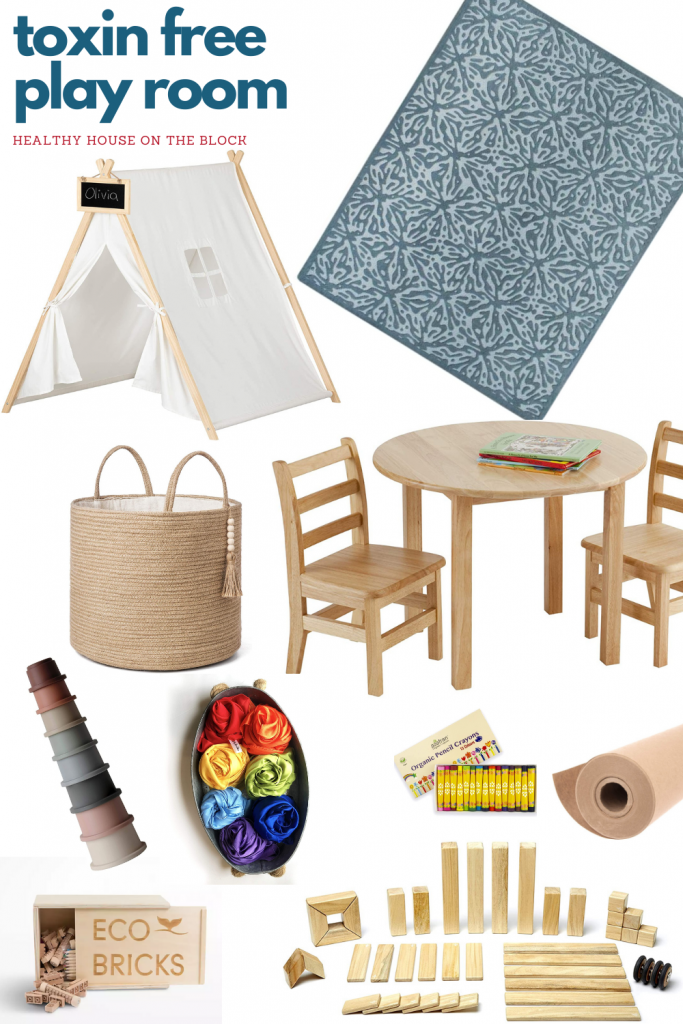
TOP PICKS FOR PLAYROOM MUST HAVES
Share this:
- Click to share on Facebook (Opens in new window) Facebook
- Click to share on LinkedIn (Opens in new window) LinkedIn
- Click to share on Reddit (Opens in new window) Reddit
- Click to share on Pinterest (Opens in new window) Pinterest
- Click to print (Opens in new window) Print
- Click to share on X (Opens in new window) X

